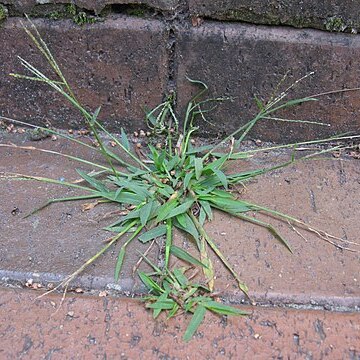Annual. Culms loosely tufted, infrequently shortly stoloniferous, 20–60 cm tall. Leaf sheaths glabrous or pilose, especially at mouth; leaf blades linear-lanceolate, 5–15 × 0.2–0.6 cm, scabrous, glabrous or adaxial surface pilose at base, apex acute; ligule 1–2 mm. Inflorescence subdigitate; racemes (2–)3–7(–10), ascending, 3–12 cm; spikelets ternate; rachis ribbonlike, winged, 0.5–0.8 mm broad, midrib low and rounded, margins serrate; pedicels angular, scabrous, with discoid tips. Spikelets elliptic-oblong, 1.4–1.9(–2.5) mm, hairs verrucose, sometimes hook-tipped; lower glume absent; upper glume lanceolate, slightly shorter than spikelet, 3(–5)-veined, intervein spaces and margins appressed-pubescent; lower lemma as long as spikelet, 5–7-veined, intervein spaces and margins pubescent, but usually glabrous flanking the middle vein; upper lemma dark brown or purplish black at maturity. Anthers 0.3–0.6 mm. Fl. and fr. Jul–Nov. 2n = 36.
Tufted annual to 900 mm high; culms erect or decumbent, rooting from lower nodes. Leaf blade 40-220 x 2-7 mm. Inflorescence digitate to subdigitate, of (2)3-9 racemes 30-140 mm long; rachis ribbon-like, broadly winged; spikelets in clusters of 3. Spikelet 1.2-2.1 mm, hairy; lower glume a membranous obscure cuff or absent; upper glume equalling to as long as spikelet, 3-nerved, hairy between nerves; internode absent; lower lemma as long as spikelet, 5-nerved, glabrous or with minute hairs, green veins very distinctive; upper lemma dark brown to almost black; nearly completely concealed; anthers 0.3-0.6 mm long.
Annual; culms 20–60 cm. high, erect or geniculately ascending, seldom stoloniferous.. Leaf-blades 3–25 cm. long, 2–7 mm. wide.. Inflorescence of (2–)3–6(–9) subdigitate racemes; racemes 3–14 cm. long, the spikelets ternate on a ribbon-like winged rhachis with low rounded midrib.. Spikelets elliptic, 1.2–2 mm. long; lower glume an obscure hyaline rim; upper glume 4/5 to as long as the spikelet, 3(–5)-nerved, with short appressed verrucose hairs between the nerves; lower lemma as long as the spikelet, 5–7-nerved, pubescent (often obscurely so) with verrucose hairs; fruit ellipsoid, dark brown to almost black.
Distinguished from no. 2 [Digitaria ischaemum (Schreb.) Muhl.] by the somewhat smaller (1.5 mm), less pubescent spikelets, the hairs not capitellate, the second glume slightly shorter; 2n=36. Pantropical, extending into our range in Ky. and s. Ind.

